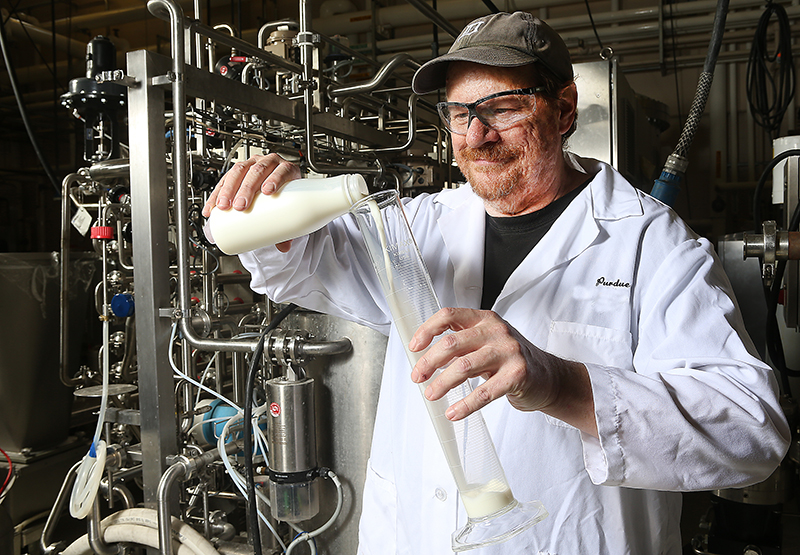July 19, 2016
Rapid, low-temperature process adds weeks to milk's shelf life
 A study conducted by Purdue University researcher Bruce Applegate, associate professor in the Department of Food Science, and others developed a process that extends the shelf life of milk. (Purdue Agriculture Communication photo/Tom Campbell)
Download image
A study conducted by Purdue University researcher Bruce Applegate, associate professor in the Department of Food Science, and others developed a process that extends the shelf life of milk. (Purdue Agriculture Communication photo/Tom Campbell)
Download image
WEST LAFAYETTE, Ind. - A rapid heating and cooling of milk significantly reduces the amount of harmful bacteria present, extending by several weeks the shelf life of one of the most common refrigerator staples in the world, according to a Purdue University study.
Bruce Applegate, Purdue associate professor in the Department of Food Science, and collaborators from Purdue and the University of Tennessee published their findings in the journal SpringerPlus, where they show that increasing the temperature of milk by 10 degrees for less than a second eliminates more than 99 percent of the bacteria left behind after pasteurization.
“It’s an add-on to pasteurization, but it can add shelf life of up to five, six or seven weeks to cold milk,” Applegate said.
Pasteurization, which removes significant amounts of harmful pathogens that can cause illness and eventually spoil dairy products, is considered a high-temperature, short-time method. Developed by Louis Pasteur in the 19th century, the treatment gives milk a shelf life of about 2-3 weeks.
The low-temperature, short-time (LTST) method in the Purdue study sprayed tiny droplets of pasteurized milk, which was inoculated with Lactobacillus and Pseudomonas bacteria, through a heated, pressurized chamber, rapidly raising and lowering their temperatures about 10 degrees Celsius but still below the 70-degree Celsius threshold needed for pasteurization. The treatment lowered bacterial levels below detection limits, and extended shelf life to up to 63 days.
“With the treatment, you’re taking out almost everything,” Applegate said. “Whatever does survive is at such a low level that it takes much longer for it to multiply to a point at which it damages the quality of the milk.”
The LTST chamber technology was developed by Millisecond Technologies, a New-York-based company.
Sensory tests compared pasteurized milk with milk that had been pasteurized and run through MST’s process. Panelists did not detect differences in color, aroma, taste or aftertaste between the products.
Phillip Myer, an assistant professor of animal science at the University of Tennessee and a co-author of the paper, said the process uses the heat already necessary for pasteurization to rapidly heat milk droplets.
“The process significantly reduces the amount of bacteria present, and it doesn’t add any extra energy to the system,” Myer said.
Myer said the promise of the technology is that it could reduce waste and allow milk to reach distant locations where transport times using only pasteurization would mean that milk would have a short shelf life upon arrival.
Applegate said the process could be tested without pasteurization to determine if it could stand alone as a treatment for eliminating harmful bacteria from milk.
The study was funded by the Agricultural Research Service of the U.S. Department of Agriculture, the Center for Food Safety Engineering at Purdue University and Millisecond Technologies.
Writer: Brian Wallheimer, 765-532-0233, brian.wallheimer@gmail.com
Sources: Bruce Applegate, 765-496-6808, applegab@purdue.edu
Phillip Myer, 865-974-3184, pmyer@utk.edu
ABSTRACT
The Effect of a novel low temperature-short time (LTST) process to extend the shelf-life of fluid milk
Phillip R. Myer1, Kyle R. Parker2, Andrew T. Kanach2, Tengliang Zhu3, Mark T. Morgan4 and Bruce M. Applegate2,3*
1 Department of Animal Science, University of Tennessee, Knoxville, TN
2 Department of Biological Sciences, Purdue University, West Lafayette, IN
3 Department of Food Science, Purdue University, West Lafayette, IN
4 Food Science and Technology Department, University of Tennessee, Knoxville, TN
Pasteurization has long been the standard method to extend the shelf-life of dairy products, as well as a means to reduce microbial load and the risk of food-borne pathogens. However, the process has limitations, which include cost effectiveness, high energy input, and reduction of product quality/organoleptic characteristics. In an effort to reduce these limitations and extend shelf-life, this study examined a novel low temperature, short time (LTST) method in which dispersed milk in the form of droplets was treated with low heat/pressure variation over a short treatment time, in conjunction with pasteurization. Lactobacillus fermentum and Pseudomonas fluorescens Migula were exposed to conventional pasteurization treatments with and without LTST. Using these organisms, the LTST addition was able to reduce microbial load below detection limits; 1.0 × 101 cfu/mL, from approximately 1.2 × 108 and 1.0 × 107 cfu/mL for L. fermentum and P. fluorescens Migula, respectively. In addition, the shelf-life of the treated, raw, and uninoculated product was prolonged from 14 to 35 days, compared with standard pasteurization, to as long as 63 days with the LTST amendment. Sensory analysis of samples also demonstrated equal or greater preference for LTST + pasteurization treated milk when compared to pasteurization alone (α = 0.05). Conventional pasteurization was effective at reducing the above mentioned microorganisms by as much as 5.0 log10 cfu/mL. However, LTST was able to achieve 7.0–8.0 log10 cfu/mL reduction of the same microorganisms. In addition, BActerial Rapid Detection using Optical scattering Technology detected and identified microorganisms isolated both pre- and post-treatment, of which the only organisms surviving LTST were Bacillus spp. Increased lethality, improved shelf-life, and equal or better organoleptic characteristics without increased energy consumption demonstrate the effectiveness of the incorporation of LTST. The improved shelf-life may potentially have major impacts in the dairy industry in terms of shipping and overall sustainability.
Agricultural Communications: (765) 494-2722;
Keith Robinson, robins89@purdue.edu
Agriculture News Page

